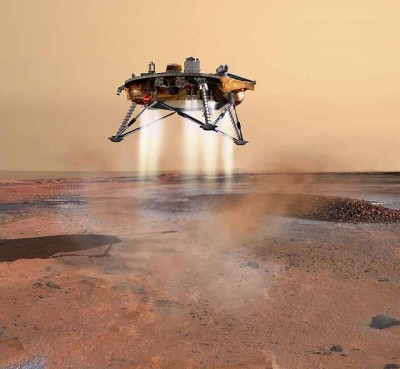
An artist’s rendition of the Phoenix Mars probe during landing. The sophisticated landing system on Phoenix allows the spacecraft to touch down within 10 kilometres (6.2 mi) of the targeted landing area. Thrusters are started when the lander is 570 metres (1,870 ft) above the surface. The navigation system is capable of detecting and avoiding hazards on the surface of Mars. (Photo: Wikimedia Commons)
A recent MIT study suggests that the Mars One colony could experience dangerous conditions with its current plans and technology.
Mars one is a proposed colony on the red planet that thousands across the world have already signed up for. The applicants are scheduled to leave earth in ten years and never return again.
The study, which was authored by Koki Ho, Samuel Schreiner, Andrew Owens and Olivier de Weck proposes a model which predicts how many resources the colony will need over certain periods of time and calculates whether or not those costs will exceed the project’s budget.
According to the predictions, the colony could be at risk of running low on oxygen just 2 months into opening operations.
The paper also found many errors in the building plans that were proposed for Mars One, specifically the location of the colony’s living spaces and farms.
The study argues that placing living quarters so close to farm areas could be dangerous because it would require nitrogen and oxygen systems to be way too close to one another.
One potential problem raised in this study could actually be solved with 3d printing. It was projected that spare parts would be the most expensive and wasteful part of the Mars One operation.
The authors wrote in their report that, “after 130 months on the Martian surface, spare parts compose 62% of the mass transported to the Martian surface.”
This is a problem that can be solved quite easily with the use of current 3d printing technology.
With the ability to 3d print 62% of their imports, the Mars One colony would take a huge leap towards creating a truly sustainable living space on Mars.
The study concludes that the cost of the operation would largely outpace the planned budget and push the project into a very dangerous situation when money ran out. Bas Lansdorp, co-founder and CEO of Mars One appeared on Bloomberg Business this week to address some of the concerns that have recently been raised about the project.
[youtube http://www.youtube.com/watch?v=vizCAWXoFhg?]


